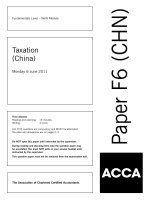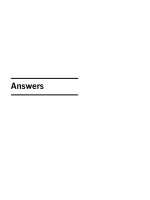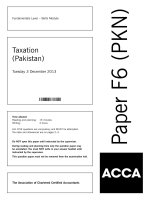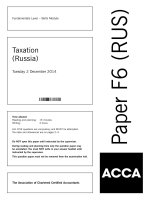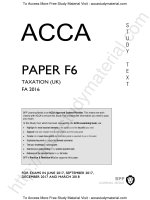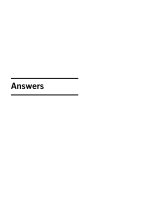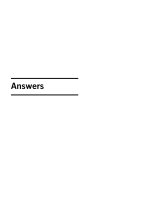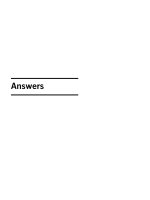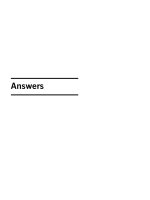ACCA f6 taxation uk 2011 dec answer
Bạn đang xem bản rút gọn của tài liệu. Xem và tải ngay bản đầy đủ của tài liệu tại đây (250.72 KB, 11 trang )
Answers
Fundamentals Level – Skills Module, Paper F6 (UK)
Taxation (United Kingdom)
1
(a)
(i)
December 2011 Answers
Philip Wind – Income tax computation 2010–11
£
9,600
18,600
–––––––
28,200
(6,990)
–––––––
21,210
–––––––
Pensions
Building society interest (14,880 x 100/80)
Personal allowance
Taxable income
Income tax
21,210 at 20%
4,242
–––––––
4,242
–––––––
Income tax liability
(1) Philip’s adjusted net income exceeds £22,900, so his personal allowance of £9,640 is reduced to £6,990 (9,640
– 2,650 (28,200 – 22,900 = 5,300/2)).
Tutorial note: The non-savings income exceeds £2,440 (9,600 – 6,990 = 2,610), so the starting rate of 10% is not
available.
(ii)
Charles Wind – Income tax computation 2010–11
£
109,400
(2,175)
––––––––
107,225
––––––––
Trading profit
Personal allowance
Taxable income
Income tax
38,200 at 20%
69,025 (107,225 – 38,200) at 40%
––––––––
107,225
––––––––
Income tax liability
7,640
27,610
––––––––
35,250
––––––––
(1) Charles’ adjusted net income of £108,600 (109,400 – 800) exceeds £100,000, so his personal allowance of
£6,475 is reduced to £2,175 (6,475 – 4,300 (108,600 – 100,000 = 8,600/2)).
(2) The basic rate tax band is extended to £38,200 (37,400 + 800) in respect of the gift aid donation.
(iii) William Wind – Income tax computation 2010–11
£
Employment income
Salary
Pension contributions
182,700
(7,300)
––––––––
175,400
23,200
6,300
––––––––
204,900
0
––––––––
204,900
––––––––
Car benefit
Fuel benefit (18,000 x 35%)
Personal allowance
Taxable income
Income tax
37,400 at 20%
112,600 at 40%
54,900 (204,900 – 150,000) at 50%
––––––––
204,900
––––––––
Income tax liability
7,480
45,040
27,450
––––––––
79,970
––––––––
(1) The list price of the motor car is restricted to a maximum of £80,000.
(2) The relevant percentage for the car benefit is 36% (15% + 21% (235 – 130 = 105/5)), but this is restricted to
the maximum of 35%.
15
(3) The motor car was available throughout 2010–11 so the benefit is £23,200 (80,000 x 35% = 28,000 – 4,800).
Tutorial notes:
(1) The fuel benefit is not reduced by the contributions made by William of £3,200 as the full cost of fuel for private
journeys has not been reimbursed.
(2) No personal allowance is available as William’s adjusted net income of £204,900 exceeds £112,950.
(b)
Philip Wind
(1) No national insurance contributions (NIC) are payable
Charles Wind
(1) Class 2 NIC of £125 (52 x 2·40) will have been paid for 2010–11.
(2) Class 4 NIC for 2010–11 will be £3,708 ((43,875 – 5,715 = 38,160 at 8%) + (109,400 – 43,875 = 65,525 at
1%)).
William Wind
(1) Class 1 NIC £5,586 ((43,875 – 5,715 = 38,160 at 11%) + (182,700 – 43,875 = 138,825 at 1%)) will have been
paid for 2010–11.
Tutorial note: Pension contributions are ignored, and benefits are not subject to employee Class 1 NIC.
(c)
(i)
(1) Charles’ adjusted net income will now be reduced to £100,000 (108,600 – 8,600), so his personal allowance
will not be restricted.
(2) The personal pension scheme contribution will also further extend the basic rate tax band by £8,600.
(3) Charles’ income tax liability for 2010–11 would therefore have been by reduced by £3,440 calculated as follows:
Personal allowance 4,300 at 40%
Basic rate band 8,600 at 20% (40% – 20%)
(ii)
£
1,720
1,720
––––––
3,440
––––––
(1) William and Crown plc should have allocated £4,400 of the contributions towards the fuel for private use, as there
will then be no fuel benefit.
(2) This will reduce the contributions for the use of the motor car by £1,200 (4,400 – 3,200).
(3) William’s income tax liability for 2010–11 would therefore have been by reduced by £2,550 (6,300 – 1,200 =
5,100 at 50%).
2
(a)
(1) An accounting period will normally start immediately after the end of the preceding accounting period.
(2) An accounting period will also start when a company commences to trade, or otherwise becomes liable to corporation
tax.
(3) An accounting period will normally finish 12 months after the beginning of the accounting period or at the end of a
company’s period of account.
(4) An accounting period will also finish when a company ceases to trade, when it otherwise ceases being liable to
corporation tax, or on the commencement of winding up procedures.
16
(b)
Starfish Ltd – Trading loss for the period ended 31 March 2011
£
Loss before taxation
Depreciation
Donation to political party
Donation not paid under gift aid
Donation paid under gift aid
Impairment loss
Legal fees – Internet domain name
– Misleading advertisement
– Issue of loan notes
Entertaining customers
Entertaining employees
Counselling services
Capital allowances (working)
£
190,000
25,030
300
600
750
0
0
2,020
0
3,600
0
0
––––––––
32,300
2,300
––––––––
192,300
––––––––
(192,300)
––––––––
(160,000)
––––––––
Trading loss
Working – Plant and machinery
WDV brought forward
Addition
Proceeds – Main pool
– Motor car
Balancing charge
Main
pool
£
23,600
2,600
–––––––
26,200
(27,500)
Motor
car
£
13,200
Allowances
£
(9,600)
–––––––
1,300
–––––––
–––––––
(3,600)
–––––––
Balancing allowance
Total allowances
(1,300)
3,600
––––––
2,300
––––––
(1) Additions are included net of input VAT, so the cost of the laptop is £2,600 (3,120 – 520 (3,120 x 20/120)).
(2) Proceeds are included net of output VAT, so the disposals from the main pool are £27,500 (33,000 (31,200 + 1,800)
– 5,500 (33,000 x 20/120)).
Tutorial notes:
(1) The cost of obtaining loan finance, even if abortive, is allowable.
(2) The only exception to the non-deductibility of entertainment expenditure is when it is in respect of employees.
(3) The costs of counselling services for redundant employees are allowable.
(4) The annual investment allowance and writing down allowances are not given for the period in which a trade ceases.
Therefore the addition is simply added into the main pool.
(5) Input VAT would not have been recovered in respect of the motor car as it was not used exclusively for business
purposes. Therefore, output VAT is not due on the disposal.
17
(c)
Trading profit
Loss relief (s.45)
Bank interest
Loss relief (s.37)
Gift aid donations
Taxable total profits
Period ended
31 March
2007
£
0
0
––––
0
600
––––
600
0
––––
600
(600)
––––
0
––––
Year ended
31 March
2008
£
64,200
(12,600)
––––––––
51,600
1,400
––––––––
53,000
(13,250)
––––––––
39,750
(1,000)
––––––––
38,750
––––––––
Year ended
31 March
2009
£
53,900
0
–––––––
53,900
1,700
–––––––
55,600
(55,600)
–––––––
0
0
–––––––
0
–––––––
Year ended
31 March
2010
£
14,700
0
–––––––
14,700
0
–––––––
14,700
(14,700)
–––––––
0
0
–––––––
0
–––––––
Period ended
31 December
2010
£
49,900
0
–––––––
49,900
0
–––––––
49,900
(49,900)
–––––––
0
0
–––––––
0
–––––––
(1) For the year ended 31 March 2008 loss relief is restricted to £13,250 (53,000 x 3/12).
Tutorial notes:
(1) Starfish Ltd would not have made a loss relief claim against total profits for the period ended 31 March 2007 as this
would have wasted the £600 of relieved gift aid donations for that period.
(2) The trading loss for the period ended 31 March 2011 can be relieved against total profits for the previous 36 months
since it is a terminal loss. Relief is as follows:
£
160,000
(49,900)
(14,700)
(55,600)
(13,250)
–––––––
26,550
–––––––
Loss
Period ended 31 December 2010
Year ended 31 March 2010
Year ended 31 March 2009
Year ended 31 March 2008
Balance unrelieved
(d)
(i)
Starfish Ltd – VAT return for the quarter ended 31 March 2011
£
Output VAT
Cash sales revenue (38,520 x 20/120)
Credit sales revenue (2,000 x 96% x 20%)
Sale of inventory (28,800 x 20/120)
Sale of non-current assets
£
6,420
384
4,800
5,500
Input VAT
Expenses (69,960 – 4,320 = 65,640 x 20/120)
Impairment loss
Purchase of non-current asset
10,940
336
520
–––––––
(11,796)
–––––––
5,308
–––––––
VAT payable
Tutorial notes:
(1) The calculation of output VAT on the credit sales revenue takes into account the discount for prompt payment,
even for the 40% of customers that did not take it.
(2) Input VAT on business entertainment is not recoverable.
(3) Relief for the impairment loss is available because the claim is made more than six months from the time that
payment was due, and the debt has been written off in the company’s books.
(ii)
(1) A sale of a business as a going concern is outside the scope of VAT, and therefore output VAT would not have been
due on the sale of the inventory or the sale of the non-current assets.
(2) Instead of VAT being payable, Starfish Ltd would have been due a refund of £4,992 (5,308 – 4,800 – 5,500).
18
3
Jorge Jung – Taxable gains computation 2010–11
£
House
Disposal proceeds
Cost
£
308,000
(98,000)
––––––––
210,000
(188,000)
(22,000)
––––––––
Principal private residence exemption
Letting relief exemption
0
Copyright
Disposal proceeds
Cost (7,000 x 8/10)
8,200
(5,600)
––––––––
2,600
0
0
Painting
Motor car
Land
Disposal proceeds
Cost
92,000
(20,240)
––––––––
71,760
Ordinary shares in Futuristic Ltd
Deemed proceeds
Cost
64,800
(26,300)
––––––––
38,500
(24,800)
––––––––
Gift relief (38,500 – 13,700)
13,700
––––––––
88,060
(10,100)
––––––––
77,960
––––––––
Chargeable gains
Annual exempt amount
Taxable gains
(1) The total period of ownership of the house is 210 months, of which 188 months qualify for exemption as follows:
Exempt
months
16
18
24
11
30
18
18
17
Occupied
Travelling overseas
Working overseas
Occupied
Working elsewhere in UK
Travelling overseas (36 – 18)
Working elsewhere in UK (48 – 30)
Occupied
Working overseas
Final 36 months
Chargeable
months
4
8
10
36
––––
188
––––
–––
22
–––
(2) The principal private residence exemption is therefore £188,000 (210,000 x 188/210).
(3) The letting relief exemption is £22,000 (210,000 x 22 (210 – 188)/210), being the amount of non-exempt gain attributable
to the period of letting. This is lower than both £40,000 and the amount of the gain exempt under the principal private
residence rules (£188,000).
(4) The cost relating to the two acres of land sold is £20,240 (28,600 x 92,000/130,000 (92,000 + 38,000)).
(5) The consideration paid for the ordinary shares in Futuristic Ltd exceeds the allowable cost by £13,700 (40,000 – 26,300).
This amount is immediately chargeable to CGT.
Tutorial notes:
(1) In calculating the principal private residence exemption periods of absence while working overseas, a maximum of four years
absence while working elsewhere in the UK and a maximum of three years absence for any reason are treated as deemed
occupation. However, the second period working overseas is not a period of deemed occupation as it was not followed by a
period of actual occupation.
(2) The copyright is a wasting asset. The cost of £7,000 must therefore be depreciated based on an unexpired life of ten years
at the date of acquisition and an unexpired life of eight years at the date of disposal.
19
(3) The painting is a non-wasting chattel, but is exempt from CGT because the gross sale proceeds were less than £6,000.
(4) Motor cars are exempt from CGT, so the loss of £3,900 (14,600 – 10,700) is not allowable.
(5) The cost of the land is £28,600 which is the value when Jorge’s father-in-law died. Jorge would have taken over this cost
when his wife transferred the land to him.
(6) Jorge and his sister are connected persons, and therefore the market value of the ordinary shares in Futuristic Ltd is used.
4
(a)
Leticia Stone – Furnished holiday letting loss 2010–11
£
Rent receivable (425 x 22)
Loan interest
Repairs (12,200 – 10,900)
Mileage allowance
Other expenses
Capital allowances (4,600 x 100%)
£
9,350
12,700
1,300
404
3,770
4,600
–––––––
(22,774)
–––––––
(13,424)
–––––––
Furnished holiday letting loss
(1) The mileage that Leticia drove in respect of the property purchase is capital in nature, and therefore does not qualify.
Her mileage allowance is therefore £404 (880 + 130 = 1,010 at 40p).
Leticia Stone – Property business loss 2010–11
£
Premium received for sub-lease
Less: 45,000 x 2% x (5 – 1)
Rent receivable – Property 2 (2,160 x 4 x 11/12)
– Property 3 (580 x 10)
– Security deposit
Rent payable (1,360 x 11)
Impairment loss
Loan interest
Other expenses
£
45,000
(3,600)
–––––––
41,400
7,920
5,800
0
–––––––
55,120
14,960
580
9,100
36,240
–––––––
(60,880)
–––––––
(5,760)
(1,670)
–––––––
(7,430)
–––––––
Furnished room (3,170 – 4,840)
Property business loss
Tutorial note: Leticia would use the normal basis of assessment in respect of the furnished room since this allows a loss to
be generated.
(b)
(1) The furnished holiday letting loss can be relieved against Leticia’s total income for 2010–11 and/or 2009–10.
(2) The property business loss, and any furnished holiday letting loss not relieved against total income, will be carried
forward and relieved against the first available property business profits.
5
(a)
(1) The group relief claim by Black Ltd is calculated after deducting brought forward trading losses and gift aid donations.
(2) The maximum potential claim by Black Ltd is therefore £355,600 (396,800 – 57,900 + 21,100 – 4,400).
(3) White Ltd’s gift aid donations of £5,600 cannot be surrendered as they can be fully relieved against the company’s
property business profit of £26,700.
(4) It is not possible to surrender capital losses as part of a group relief claim.
(5) Only current year trading losses can be group relieved, so the maximum potential surrender by White Ltd is £351,300.
(6) The maximum group relief claim is therefore £351,300.
20
(b)
Brown Ltd – Corporation tax liability for the year ended 31 March 2011
Trading profits
Gift aid donations
Taxable total profits
Corporation tax at 21%
Double taxation relief
Total
UK
£
212,000
(22,000)
––––––––
190,000
––––––––
39,900
(39,600)
––––––––
300
––––––––
£
12,000
(12,000)
–––––––
0
–––––––
–––––––
–––––––
First
branch
£
160,000
0
––––––––
160,000
––––––––
33,600
(33,600)
––––––––
0
––––––––
Second
branch
£
40,000
(10,000)
–––––––
30,000
–––––––
6,300
(6,000)
–––––––
300
–––––––
Tutorial notes:
(1) The balance of the gift aid donations of £10,000 are deducted from the profits of the second overseas branch since
it has paid the lower rate of corporation tax of 15% (6,000/40,000 x 100). The first overseas branch has paid
corporation tax at the rate of 30% (48,000/160,000 x 100).
(2) The first overseas branch has paid overseas corporation tax of £48,000, but double taxation relief is restricted to the
related UK corporation tax of £33,600.
(3) The second overseas branch has paid overseas corporation tax of £6,000, and this is lower than the related UK
corporation tax of £6,300.
(c)
Blu Reddy – Inheritance tax computation
£
Lifetime transfer 15 January 2011
Value of shares held before the transfer
300,000 x £4
Value of shares held after the transfer
100,000 x £2
1,200,000
(200,000)
––––––––––
1,000,000
0
168,750
––––––––––
1,168,750
––––––––––
Net chargeable transfer
IHT liability 325,000 at nil%
675,000 x 20/80
Gross chargeable transfer
Additional liability arising on death 31 May 2015
Gross chargeable transfer
1,168,750
––––––––––
0
337,500
(135,000)
––––––––––
202,500
(168,750)
––––––––––
33,750
––––––––––
IHT liability 325,000 at nil%
843,750 at 40%
Taper relief reduction – 40%
IHT already paid
Additional liability
21
Fundamentals Level – Skills Module, Paper F6 (UK)
Taxation (United Kingdom)
December 2011 Marking Scheme
Marks
1
(a)
(i)
Philip Wind
Pensions
Building society interest
Personal allowance
Income tax
½
½
2
1
–––
4
(ii)
Charles Wind
Trading profit
Personal allowance
Extension of basic rate band
Income tax
½
2
½
1
–––
4
(iii) William Wind
Salary
Pension contributions
Car benefit – List price
– Relevant percentage
– Contribution
– Calculation
Fuel benefit
Personal allowance
Income tax
½
1
½
1
½
½
1
1
1
–––
7
(b)
Philip Wind
No NIC
Charles Wind
Class 2 NIC
Class 4 NIC
William Wind
Class 1 NIC
½
½
1½
1½
–––
4
(c)
(i)
Charles Wind
Personal allowance
Basic rate band
Income tax liability
1
1
1
–––
3
(ii)
William Wind
Allocation
Contributions for use of motor car
Income tax liability
1
1
1
–––
3
–––
25
–––
23
2
(a)
Marks
2
2
–––
When an accounting period starts
When an accounting period finishes
4
(b)
Depreciation
Donations
Impairment loss
Legal fees
Entertaining customers
Entertaining employees
Counselling services
P & M – WDV brought forward
– Addition
– Main pool proceeds
– Motor car proceeds
– Balancing adjustments
½
1½
1
1½
½
½
½
1
1½
2
1
½
–––
12
(c)
Trading profit
Relief for 2007 loss –
–
Bank interest
Relief for 2011 loss –
–
Gift aid donations
½
½
½
½
1
1
1
–––
Period ended 31 March 2007
Carry forward
Year ended 31 March 2008
Other periods
5
(d)
(i)
Output VAT – Cash sales revenue
– Credit sales revenue
– Inventory
– Sale of non-current assets
Input VAT – Expenses
– Impairment loss
– Purchase of non-current asset
1½
1½
1
½
1
1
½
–––
7
(ii)
Output VAT not due
VAT refund
1
1
–––
2
–––
30
–––
3
House – Proceeds
– Cost
– Period of exemption
– Principal private residence exemption
– Letting relief exemption
Copyright – Proceeds
– Cost
Painting
Motor car
Land – Proceeds
– Relevant cost
– Apportionment of cost
Ordinary shares – Deemed proceeds
– Cost
– Gift relief
Annual exempt amount
½
½
3
1
1
½
1½
½
½
½
1
1
1
½
1½
½
–––
15
–––
24
Marks
4
(a)
Furnished holiday letting loss
Rent receivable
Loan interest
Repairs
Mileage allowance
Other expenses
Capital allowances
Business property loss
Lease premium received
Rent receivable – Property 2
– Property 3
– Security deposit
Rent payable
Impairment loss
Loan interest
Other expenses
Furnished room
½
1
1
1½
½
1
1
1
1
½
1
1
½
½
1
–––
13
(b)
Furnished holiday letting loss
Property business loss
1
1
–––
2
–––
15
–––
5
(a)
Maximum potential claim
Gift aid donations
Capital losses
Maximum potential surrender
Maximum claim
2
1
½
1
½
–––
5
(b)
Trading profits
Gift aid donations
Corporation tax
Double taxation relief
½
1½
½
1½
–––
4
(c)
Lifetime transfer
Value transferred
IHT liability
Additional liability arising on death
Gross chargeable transfer
IHT liability
Taper relief
IHT already paid
2
1½
½
½
1
½
–––
6
–––
15
–––
25
